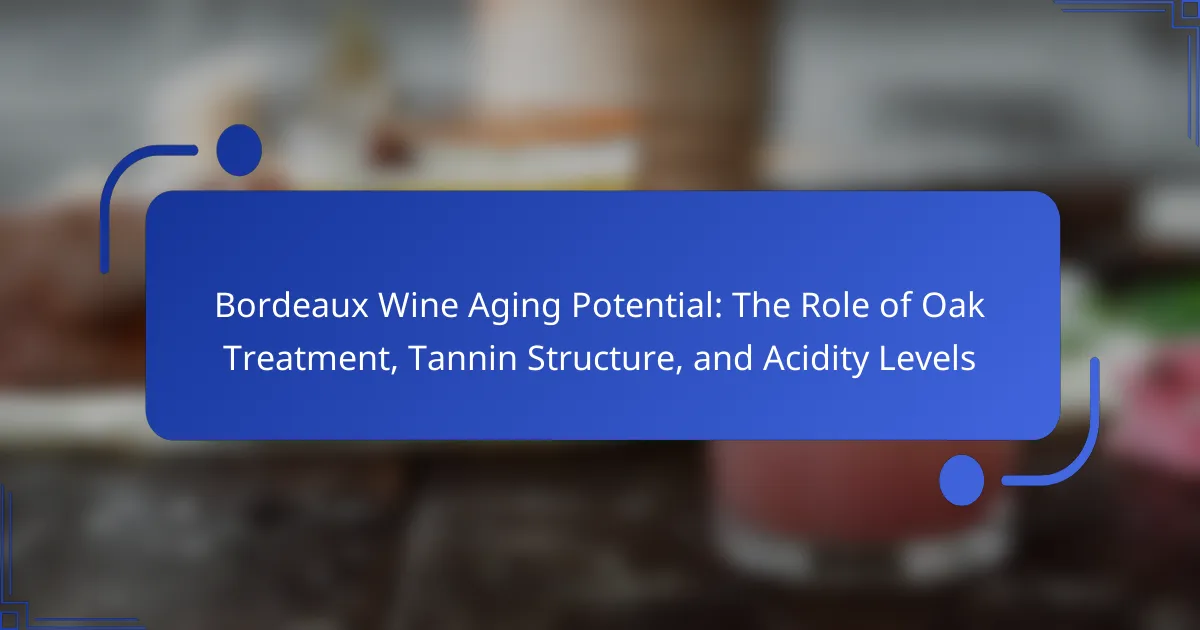
What is Bordeaux Wine Aging Potential?
Bordeaux wine aging potential refers to the ability of Bordeaux wines to improve in quality over time. This potential is influenced by factors such as tannin structure, acidity levels, and oak treatment. Wines with higher tannin and acidity levels typically age better. For instance, Cabernet Sauvignon and Merlot from Bordeaux often exhibit significant aging potential. Research indicates that wines can develop complex flavors and aromas over years of proper storage. Aged Bordeaux wines may show notes of leather, tobacco, and dried fruit. The aging process can last from a few years to several decades, depending on the wine’s characteristics.
Why is aging potential important for Bordeaux wines?
Aging potential is important for Bordeaux wines because it enhances their complexity and flavor profile over time. Bordeaux wines, particularly those from renowned regions, often possess high tannin levels and acidity. These attributes contribute to the wine’s ability to evolve and develop richer flavors as they age.
As Bordeaux wines mature, they undergo chemical changes that soften tannins and integrate flavors. This process can result in a more harmonious and balanced wine. For instance, a well-aged Bordeaux can exhibit notes of dark fruit, leather, and spice that may not be present in younger wines.
Moreover, the aging potential often reflects the quality of the grapes and the winemaking techniques used. Bordeaux wines with strong aging potential are typically crafted from optimal vineyard sites and undergo careful vinification. This is evident in prestigious Bordeaux labels, which frequently receive high scores from wine critics based on their aging capabilities.
What factors influence the aging potential of Bordeaux wines?
The aging potential of Bordeaux wines is influenced by several key factors. These factors include tannin structure, acidity levels, and oak treatment. Tannins, derived from grape skins and seeds, provide structure and preservation. Higher tannin content enhances aging potential. Acidity acts as a natural preservative, keeping the wine fresh over time. Wines with balanced acidity age better. Oak treatment contributes complexity and stability. The interaction between wine and oak barrels can enhance flavor and aroma. These factors collectively determine how well a Bordeaux wine can evolve and improve with age.
How does aging affect the flavor profile of Bordeaux wines?
Aging significantly enhances the flavor profile of Bordeaux wines. Over time, these wines develop complex flavors and aromas. Initial fruity notes evolve into deeper characteristics such as leather, tobacco, and earthiness. The tannins soften, contributing to a smoother mouthfeel. Acidity levels also balance, leading to a more harmonious taste. Oak aging introduces additional layers of vanilla, spice, and toast. Studies indicate that well-aged Bordeaux wines can reach their peak flavor potential after 10 to 30 years. This maturation process is essential for achieving the wine’s full expression.
What role does oak treatment play in Bordeaux wine aging?
Oak treatment significantly influences the aging process of Bordeaux wine. It enhances flavor complexity and adds aromatic characteristics. Oak barrels impart compounds such as vanillin, which contribute notes of vanilla and spice. The tannins from oak also integrate with the wine’s structure, adding depth and smoothness. Additionally, oak treatment aids in the oxidation process, which softens harsh tannins over time. This gradual evolution improves the wine’s overall balance and mouthfeel. Studies show that wines aged in oak develop more nuanced flavors compared to those aged in stainless steel. Bordeaux wines typically undergo this treatment for 12 to 24 months, depending on the desired profile.
How does the type of oak affect the aging process?
The type of oak significantly affects the aging process of Bordeaux wine. Different oak species impart distinct flavors and tannin structures. French oak, for instance, is known for its subtle spice and vanilla notes. It has a tighter grain, allowing for a slower oxygen exchange. This slow exchange enhances the wine’s complexity and aging potential. American oak, on the other hand, tends to provide stronger vanilla and coconut flavors. Its wider grain allows for a faster oxygen interaction, which can accelerate aging. The choice of oak also influences the wine’s tannin profile. Tannins extracted from oak contribute to the wine’s structure and mouthfeel. Therefore, the type of oak plays a crucial role in determining the overall character and aging potential of Bordeaux wine.
What are the different methods of oak treatment used in Bordeaux wines?
The different methods of oak treatment used in Bordeaux wines include barrel aging, toasting, and micro-oxygenation. Barrel aging involves maturing wine in oak barrels, which imparts flavors and tannins. Toasting refers to the process of heating the inside of the barrel, influencing the flavor profile. Micro-oxygenation introduces small amounts of oxygen during aging, enhancing tannin integration. These methods are essential for developing complexity and structure in Bordeaux wines. Historical practices show that these treatments significantly affect the wine’s aging potential and overall quality.

How does tannin structure impact Bordeaux wine aging potential?
Tannin structure significantly influences the aging potential of Bordeaux wine. Tannins are polyphenolic compounds that provide astringency and structure. In Bordeaux wines, tannins contribute to the wine’s overall balance and longevity. A higher concentration of tannins typically enhances aging potential. Tannins stabilize color and protect against oxidation during aging. Additionally, the interaction of tannins with other components, such as acids and sugars, affects the wine’s development over time. Research indicates that wines with well-integrated tannins age more gracefully, developing complex flavors. Thus, the structural integrity of tannins is crucial for Bordeaux wines to mature effectively.
What are tannins and how do they contribute to wine aging?
Tannins are polyphenolic compounds found in grape skins, seeds, and stems. They contribute to wine aging by providing structure and stability. Tannins interact with other components in wine, such as acids and sugars. This interaction helps to preserve the wine over time. As wine ages, tannins undergo polymerization, which softens their astringency. This process leads to a smoother mouthfeel and enhanced flavor complexity. Studies show that wines with higher tannin levels often have better aging potential. Bordeaux wines, known for their tannin structure, exemplify this characteristic.
How does the tannin level vary among different Bordeaux wines?
Tannin levels vary significantly among different Bordeaux wines. Generally, red Bordeaux wines have higher tannin levels compared to whites. Cabernet Sauvignon, a primary grape in Bordeaux, typically exhibits robust tannins. Merlot, another key grape, tends to have softer tannins. The tannin structure influences the aging potential of these wines. Wines with higher tannin levels often age better, developing complexity over time. Factors such as grape variety, vineyard location, and vinification techniques also affect tannin levels. For example, wines from the Left Bank usually have more tannin due to the dominance of Cabernet Sauvignon. In contrast, wines from the Right Bank, which favor Merlot, have lower tannin levels.
What is the relationship between tannin structure and wine texture?
Tannin structure directly influences wine texture. Tannins, which are polyphenolic compounds, contribute to a wine’s mouthfeel and astringency. The size and complexity of tannin molecules affect how they interact with proteins in saliva. Smaller tannins can create a smoother texture, while larger tannins may lead to a more astringent sensation. Research indicates that the balance of tannin structure can enhance the overall mouthfeel of Bordeaux wines. This relationship is crucial for aging potential, as well-structured tannins can soften over time, improving texture.
How does acidity influence the aging potential of Bordeaux wines?
Acidity significantly influences the aging potential of Bordeaux wines. Higher acidity levels contribute to the wine’s ability to age gracefully over time. Acidity acts as a natural preservative, helping to maintain freshness and balance in the wine. It also enhances the wine’s structure, allowing for better integration of flavors during aging. Wines with balanced acidity tend to develop more complex aromas and flavors as they mature. In Bordeaux, the ideal acidity level varies by grape variety and vintage. For instance, Cabernet Sauvignon often exhibits higher acidity, which supports its aging potential. Studies show that wines with a pH below 3.6 generally age better, retaining their quality for longer periods. This indicates that acidity is a critical factor in determining the longevity and overall quality of Bordeaux wines.
What is the role of acidity in preserving wine during aging?
Acidity plays a crucial role in preserving wine during aging. It helps maintain freshness and balance in the wine. Higher acidity can inhibit the growth of unwanted bacteria. This characteristic contributes to the wine’s longevity and stability over time. Acidity also enhances the wine’s flavor profile and complexity. It acts as a natural preservative, preventing oxidation. Wines with balanced acidity age more gracefully. Studies show that wines with higher acidity tend to develop more favorable aging characteristics.
How do different acidity levels affect the taste of aged Bordeaux wines?
Different acidity levels significantly affect the taste of aged Bordeaux wines. Higher acidity enhances freshness and balance in the wine. It preserves the wine’s structure and promotes longevity during aging. Wines with lower acidity may taste flabby or overly ripe. They often lack the crispness that characterizes well-aged Bordeaux. Aged Bordeaux wines typically benefit from moderate acidity, which contributes to complexity. Studies show that acidity influences flavor perception and mouthfeel. For instance, wines with balanced acidity exhibit greater depth and nuanced flavors. This balance is crucial for the overall enjoyment of the wine.

What are the interactions between oak treatment, tannins, and acidity in Bordeaux wines?
Oak treatment, tannins, and acidity interact significantly in Bordeaux wines. Oak barrels impart flavors and compounds that enhance tannin structure. Tannins contribute to the wine’s astringency and aging potential. Acidity balances the wine, providing freshness and preventing spoilage. The interaction of these elements creates complexity in flavor and texture. For example, higher acidity can soften the perception of tannins. Conversely, more tannins can enhance the perception of acidity. This balance is crucial for the aging potential of Bordeaux wines. Research indicates that optimal oak treatment can elevate the quality of tannins and acidity, leading to greater aging potential.
How do these factors work together to enhance aging potential?
Oak treatment, tannin structure, and acidity levels work together to enhance the aging potential of Bordeaux wine. Oak treatment contributes to the complexity and depth of flavor by adding vanilla and spice notes. Tannins provide structure and stability, which help preserve the wine over time. Acidity acts as a natural preservative, balancing sweetness and enhancing freshness. Together, these factors create a harmonious profile that allows the wine to evolve gracefully. Studies show that wines with higher tannin and acidity levels age better, maintaining their integrity for decades. This interplay ensures that Bordeaux wines develop nuanced flavors and aromas as they mature.
What is the significance of balance among oak, tannins, and acidity?
The balance among oak, tannins, and acidity is crucial for the aging potential of Bordeaux wine. Oak contributes flavors and aromas, enhancing complexity. Tannins provide structure and astringency, influencing mouthfeel. Acidity adds freshness and balance, preventing the wine from becoming flat. A harmonious interplay among these elements promotes a well-rounded profile. Wines that achieve this balance age more gracefully. Studies show that optimal levels of these components lead to a more enjoyable tasting experience over time. Properly balanced Bordeaux wines can develop richer flavors and aromas as they mature.
What are the best practices for aging Bordeaux wines effectively?
The best practices for aging Bordeaux wines effectively include proper storage conditions and selecting the right vintage. Bordeaux wines should be stored in a cool, dark, and humid environment. Ideal temperatures range from 50°F to 55°F (10°C to 13°C). Consistent temperature is crucial to prevent spoilage.
Wines should be stored horizontally to keep the cork moist. This prevents air from entering the bottle. The humidity level should be around 70% to avoid cork drying out. A wine cellar or a dedicated wine fridge is ideal for these conditions.
Choosing the right vintage is also essential. Bordeaux wines can age well for 10 to 50 years, depending on the blend and vintage quality. Wines with high tannin levels and acidity typically age better.
Monitoring the wine periodically is important. This helps to determine when the wine has reached its optimal drinking window. A well-aged Bordeaux will exhibit complex flavors and aromas. Proper aging enhances the wine’s character and depth.
How can wine collectors optimize the aging conditions for Bordeaux wines?
Wine collectors can optimize the aging conditions for Bordeaux wines by maintaining specific environmental factors. Temperature should be kept between 55°F and 65°F (13°C to 18°C). Humidity levels should be around 70% to prevent cork drying. Light exposure should be minimized to avoid degradation. Vibration should be avoided as it disrupts sediment. Bordeaux wines benefit from consistent conditions rather than fluctuations. Proper storage in a wine cellar or dedicated wine fridge is essential. These conditions enhance the aging process and preserve wine quality. Studies show that optimal aging improves flavor complexity and aroma.
Bordeaux wine aging potential refers to the ability of Bordeaux wines to improve in quality over time, influenced by factors such as tannin structure, acidity levels, and oak treatment. Higher tannin and acidity levels generally enhance a wine’s aging capability, allowing for the development of complex flavors and aromas. The article explores how these elements interact to create a harmonious profile that promotes effective aging, alongside best practices for optimal storage conditions. It also examines the significance of oak treatment and the variations in tannin levels across different Bordeaux wines, providing a comprehensive understanding of their aging potential.
